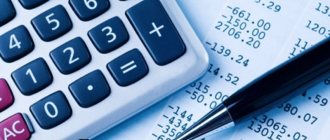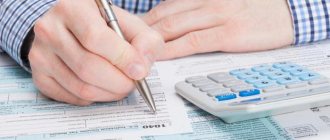Balance sheet reformation: postings if profit is made
The accounting of LLC “Success” at the end of the year for account 99 reflects:
- subaccount 99/1 “Profits and losses” - 210,000 rubles. (credit balance);
- subaccount 99/2/1 “Conditional income tax expense” - 42,000 rubles. (debit balance);
- subaccount 99/2/3 “PNO” - 6,300 rubles. (debit balance).
When reforming the balance sheet, the postings will be as follows:
- Dt 99/1 Kt 99/9 - 210,000 rubles;
- Dt 99/9 Kt 99/2/1 - 42,000 rubles;
- Dt 99/9 Kt 99/2/3 — 6,300 rub.
Then the balance of subaccount 99/9 is calculated: 210,000 – 42,000 – 6,300 = 161,700 rubles. It will be credit. To complete the reformation of the balance sheet posting Dt 99/9 Kt 84 - 161,700 rubles. close subaccount 99/99 and show net profit at the end of the year.
| ★ Best-selling book “Accounting from scratch” for dummies (understand how to do accounting in 72 hours) > 8,000 books purchased |
Results
Balance sheet reformation is a process that leads to the resetting of data on accounts 90, 91 and 99. The first 2 accounts, which have a zero final balance due to the rules for forming the figures reflected on them, are closed with internal postings.
Account 99 is closed using internal entries that close the analytics for it at the expense of the overall financial result, and a final entry that writes off the amount of net profit (loss) to account 84. You can find more complete information on the topic in ConsultantPlus.
Full and free access to the system for 2 days. https://youtu.be/s4B9tfkxo7I
Balance sheet reformation: postings if a loss is received
The accounting of LLC “Success” at the end of the year for account 99 reflects:
- subaccount 99/1 “Profits and losses” - 210,000 rubles. (debit balance);
- subaccount 99/2/2 “Conditional income for income tax” - 42,000 rubles. (credit balance);
- subaccount 99/2/3 “PNO” - 6,300 rubles. (debit balance).
When reforming the balance sheet, the postings will be as follows:
- Dt 99/9 Kt 99/ 1 - 210,000 rubles;
- Dt 99/2/2 Kt 99/9 - 42,000 rubles;
- Dt 99/9 Kt 99/2/3 — 6,300 rub.
Then the balance of subaccount 99/9 is calculated: –210,000 + 42,000 – 6,300 = 174,300 rubles. It will be a debit. In conclusion, you need to close the subaccount Dt 84 Kt 99/9 - 174,300 rubles.
Balance reform in 1C 8.3
In the popular accounting program 1C, the balance sheet reformation occurs automatically in the “regular operation” document when closing the last month of the year:
You can see the generated transactions by clicking on the “balance sheet reformation” hyperlink, and then the “show transactions” item:
In the 1C demo database you can see the following wiring:
Tax features of calculations
Due to differences in the recognition of income and expenses in accounting and tax accounting, the following situation is possible: according to tax accounting data, the company’s activities are unprofitable, but in accounting there is a profit. In this case, the amount of income tax cannot be negative, and in this case there is no income tax (no profit - no tax). According to the law, the resulting tax loss can be taken into account over the next 10 years (Article 283 of the Tax Code of the Russian Federation).
In the described situation, the accountant will have to record a deferred tax asset as of December 31. It is easy to calculate: the amount of the tax loss should be multiplied by the income tax rate. You need to make an entry for the amount received: Dt 09 Kt 68.
As a result, the amount of accrued income tax becomes zero, and there are no discrepancies between tax accounting and financial statements.
Closing account 99
Unlike the account. 90 and 91, this account does not reset throughout the year. The balance formed on it reflects the interim results of the financial and economic work of the enterprise. When the balance sheet is reformed, the debit and credit turnover of the account is compared. 99. Balance Kd reflects net income. The debit balance will show that the company has incurred a loss.
When reforming the account balance. 99, according to the Instructions, is closed with a final entry dated December 31. The amount of net income received is transferred to the CD account. 84. If a loss occurs at the end of the period, it is included in the Db account. 84. Thus, the entry will be as follows: Db 99 Kd 84, subac. “Retained income of the reporting period” - write-off of the net (undistributed) profit of the year.
Or: Db 84, subaccount. “Uncovered losses of the reporting period”, Kd 99 - reflects the uncovered loss for the reporting year.
As a result, the account balance 99 will be reset. At the same time, subaccounts are also opened for this account. Let's consider what to do with them.
Dates and results
In terms of timing, the reformation should not be shelved. It must be carried out before the end of the year, no later than December thirty-first. The reformation of the balance sheet should begin with an inventory and end with the formation of accounting entries for the amount of profit or loss (as of December 31 of the reporting period). The balance sheet conversion procedure itself is not labor-intensive, but additional calculations and postings may be required in the event of a tax loss.
The final financial result is reflected in the reporting. And well-written reporting is the key to correct management decisions made by the company’s management and its owners, protection from various sanctions that are possible when reporting lines are distorted.
Closing the organization's income and expense accounts
Accounts 90, which accumulates the enterprise's income and expenses for normal types of production or activity, and 91, intended for other income and expenses, are reset to zero every calendar month. In this case, the financial result obtained by comparing turnover in subaccounts of accounts 90 and 91 is transferred to account 99.
In accounting, if a profit is received from sales and other activities, an entry is made to write it off:
Debit account 90-9 (s/account 91-9) / Credit account. 99.
When a loss is generated for the month, it is written off using the following operation:
Debit account 99 / Credit account. 90-9 (s/sch. 91-9).
Every month at the end of the period, accounts 90, 91 have zero balances, but their subaccounts retain some balances of funds, which are reset to zero by internal operations (on accounts 90-9 and 91-9) in the process of balance sheet reformation according to data as of December 31 of the year being completed .
How to reform the balance sheet?
Balance sheet reformation is an annual procedure carried out on December 31 to determine the financial result of the reporting year (net profit or loss). They carry out reformation after all transactions of financial and economic activity are reflected in accounting, that is, the last entry is December 31 <*>.
The Reformation can be divided into two stages.
1. Closing sub-accounts opened for accounts 90 “Income and expenses from current activities” and 91 “Other income and expenses”.
Account 90 is closed monthly. To do this, debit and credit turnovers are compared for subaccounts opened to account 90. The difference between debit and credit turnovers is recorded monthly:
- debit 90-11 - credit 99 - if profit is received from current activities;
- debit 99 - credit 90-11 - if a loss is received from current activities.
Similarly, at the end of each month, debit and credit turnovers in subaccounts opened to account 91 are compared, and the balance of other income and expenses is determined, which is reflected in the debit (credit) of account 99 and the credit (debit) of subaccount 91-5 <*>.
It turns out that for accounts 90 and 91 there is no balance in synthetic accounting at the end of each month. However, the subaccounts of these accounts continue to contain balances that accumulate throughout the reporting year and are closed through reformation of the balance sheet as of December 31 with internal entries to subaccount 90-11 (91-5) <*>.
As a result of the entries made, the debit and credit turnovers on the subaccounts opened to account 90 (91) will be equal. The balance both for accounts 90 (91) as a whole and for all sub-accounts opened to them will be equal to zero.
Example 1. The first stage of the reformation
The following business transactions were reflected during the year:
— revenue from sales (debit 62 — credit 90-1) — 2,196,000 rubles;
- VAT accrued (debit 90-2 - credit 68-2) - 366,000 rubles;
- the cost of goods sold is written off (debit 90-4 - credit 43) - 1,268,000 rubles;
- administrative expenses written off (debit 90-5 - credit 26) - 328,000 rubles;
- profit from sales is reflected (debit 90-11 - credit 99) - 234,000 rubles. (RUB 2,196,000 - RUB 366,000 - RUB 1,268,000 - RUB 328,000).
| Account 90 “Income and expenses from current activities” | ||
| Debit | Credit | |
| Opening balance | — | — |
| Revolutions | 366000 1268000 328000 234000 | 2196000 |
| Total turnover | 2196000 | 2196000 |
| Closing balance | — | — |
On December 31, 2020, it is necessary to close all subaccounts to account 90:
debit 90-1 - credit 90-11 in the amount of 2,196,000 rubles. — subaccount 90-1 was closed at the end of the year;
debit 90-11 - credit 90-2 in the amount of 366,000 rubles. — subaccount 90-2 was closed at the end of the year;
debit 90-11 - credit 90-4 in the amount of 1,268,000 rubles. — subaccount 90-4 was closed at the end of the year;
debit 90-11 - credit 90-5 in the amount of 328,000 rubles. — subaccount 90-5 is closed at the end of the year.
| Subaccount 90-1 | Subaccount 90-2 | Subaccount 90-4 | Subaccount 90-5 | Subaccount 90-11 | ||||||
| Debit | Credit | Debit | Credit | Debit | Credit | Debit | Credit | Debit | Credit | |
| Opening balance | — | — | — | — | — | — | — | — | — | — |
| Revolutions | 2196000 | 2196000 | 366000 | 366000 | 1268000 | 1268000 | 328000 | 328000 | 234000 366000 1268000 328000 | 2196000 |
| Total turnover | 2196000 | 2196000 | 366000 | 366000 | 1268000 | 1268000 | 328000 | 328000 | 2196000 | 2196000 |
| Closing balance | — | — | — | — | — | — | — | — | — | — |
Thus, as of 01/01/2018, the balance both in the overall account 90 and in all sub-accounts opened to it will be zero.
2. Closing account 99 “Profits and losses”.
Account 99 is intended to summarize information on the formation of the final financial result of the organization’s activities for the reporting period. This account reflects profit (loss) from current activities and the balance of other income and expenses throughout the year. In addition, account 99 reflects the accrual of income taxes, deferred tax liability, write-off of deferred tax assets, etc.
At the end of the reporting year, account 99 is closed <*>.
Example 2. Second stage of reformation
At the end of the year, the organization:
- received profit from current activities - 234,000 rubles. (debit 90-11 - credit 99);
- received profit from financial activities - 96 rubles. (debit 91-5 - credit 99);
— accrued income tax — 42,137.28 rubles. (debit 99 - credit 68-3).
As of December 31, 2017, the organization recorded a profit in the amount of 191,958.72 rubles. (234,000 rub. + 96 rub. - 42,137.28 rub.). It is written off to retained earnings with the last entry in December: debit 99 - credit 84.
| Account 99 “Profits and losses” | ||
| Debit | Credit | |
| Opening balance | — | — |
| Revolutions | 42137,28 191958,72 | 234000 96 |
| Total turnover | 234096 | 234096 |
| Closing balance | — | — |
After the balance reform, there will be no balance on accounts 90, 91 and 99. Account 84 will contain the amount of net retained earnings or net uncovered loss.
Preparing for the end of the year
Balance sheet reformation refers to the final entry in December of the reporting year, which determines net profit or net loss. This entry is made with entries dated December 31, after all transactions of financial and economic activities are reflected in the accounting records. The balance sheet reform itself consists of two stages:
1) closing financial results accounts 90 “Sales” and 91 “Other income and expenses”;
2) reflecting net profit or net loss as part of retained earnings or uncovered loss.
Before moving directly to the closing of the year, you need to make sure that all documents are submitted to the accounting department and all financial and economic transactions are reflected in the accounting accounts. Only an inventory can provide complete confidence that the accounting records reflect all the assets and liabilities of the organization. Let us remind you that before preparing annual reports it is necessary to carry out an inventory. According to Art. 11 of Federal Law N 402-FZ, assets and liabilities are subject to inventory, which identifies the actual presence of the relevant objects and compares them with data from accounting registers. At the same time, the legislator established that the cases, timing and procedure for conducting an inventory, as well as the list of objects subject to inventory, are determined by the economic entity, with the exception of the mandatory inventory. Mandatory inventory is provided for by the legislation of the Russian Federation, federal and industry standards. At the time of preparation of this material, no new standards regulating the procedure for conducting mandatory inventory have been adopted. But until the state accounting regulatory bodies approve the federal and industry standards provided for by Federal Law N 402-FZ, the rules for maintaining accounting records and preparing financial statements approved by the authorized federal executive bodies and the Bank of Russia before the entry into force of this Federal Law (p. 1 article 30). The following regulations continue to apply today:
- Regulations on accounting and reporting, approved by Order of the Ministry of Finance of Russia dated July 29, 1998 N 34n;
- Guidelines for inventory of property and financial obligations, approved by Order of the Ministry of Finance of Russia dated June 13, 1995 N 49;
- Accounting Regulations “Accounting Statements of an Organization” (PBU 4/99), approved by Order of the Ministry of Finance of Russia dated July 6, 1999 N 43n;
- Guidelines for accounting of inventories, approved by Order of the Ministry of Finance of Russia dated December 28, 2001 N 119n;
- Guidelines for accounting of fixed assets, approved by Order of the Ministry of Finance of Russia dated October 13, 2003 N 91n.
These regulations provide for mandatory inventory before drawing up annual financial statements (except for property, the inventory of which was carried out no earlier than October 1 of the reporting year). An inventory of fixed assets is carried out once every three years, and of library collections - once every five years. In organizations located in the Far North and equivalent areas, inventory of goods, raw materials and materials can be carried out during the period of their smallest balances.
Thus, conducting an inventory before drawing up an annual report, that is, before closing the year, is the responsibility of the organization, and not its desire or unwillingness. Let us note that the inventory will help the “simplified” ones, among other things, to avoid mistakes when calculating the tax base for the tax paid under the simplified tax system. Discrepancies identified during the inventory between the actual availability of objects and the data of the accounting registers are subject to registration in accounting in the reporting period to which the date as of which the inventory was carried out relates. Of course, the inventory results must also be reflected in tax accounting for a given tax period.
Let us remind you that all property of the organization, regardless of its location, and all types of financial obligations are subject to inventory. In addition, inventories are subject to inventory and other types of property that do not belong to the organization, but are listed in the accounting records (those in custody, rented, received for processing), as well as property that is not accounted for for any reason. An inventory of property is carried out at its location and to the financially responsible person.
As for the timing of the inventory, they are set by the entity itself and can begin after October 1, while the inventory of calculations and reserves is carried out at the end of the reporting year. At the same time, since according to paragraph 1 of Art. 15 of Federal Law N 402-FZ, the reporting year is a calendar year - from January 1 to December 31 inclusive, an inventory of liabilities must be carried out as of December 31 inclusive. Accordingly, the results of the inventory must be reflected in accounting entries by date no later than December 31 before the close of the year.
The question of liability for failure to take inventory is often asked. There is no liability for this as such. But without an inventory carried out before drawing up the annual report, the accountant cannot be sure of the reliability of these reports. In addition, without an annual inventory, an organization cannot count on an unconditionally positive audit opinion in a situation where it is subject to a mandatory audit. Sometimes the need for a proactive audit arises later.
When to Reform the Balance Sheet
Due to its semantic purpose, the reformation of the balance sheet is the last accounting operation performed in the current year. Accordingly, it is carried out on the last day of the year - December 31.
However, there is 1 exception to this rule. At other times, the balance sheet is reformed if the company is liquidated before the end of the calendar year. The liquidation process is accompanied by the preparation of a liquidation balance sheet, which is subject to the general rules for the formation of this report, but is compiled on a different time frame.
For more information about the liquidation balance sheet, read the material “Liquidation balance sheet - an example of a zero balance sheet in the new form”.
The final stage of the reformation
At the final stage, account 99 is closed. Let us recall that in this account, in addition to the financial results generated in correspondence with accounts 90 and 91, the following are taken into account:
- those who do not apply PBU 18/02 – the amount of accrued income tax;
- applying PBU 18/02 – the values of conditional income tax expense (income) and permanent tax liabilities.
For information on what kind of transactions when applying PBU 18/02 in accounting reflect the process of calculating the amount of income tax payable to the budget, read the article “In which accounts is the amount of income tax taken into account?” .
The following may also be taken into account:
- income tax recalculations;
- accrued tax penalties.








